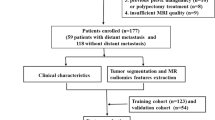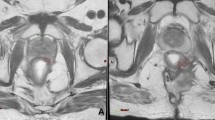Abstract
Rationale and objectives
The study aimed to investigate whether dynamic contrast-enhanced MRI parameters and preoperative radiological features (DCER-Features) add value to the clinicopathologic model for predicting metachronous metastases in rectal cancer patients.
Materials and methods
From January 2014 to December 2020, 859 patients in the PACS system were retrospectively screened. Of the initial 722 patients with surgically confirmed rectal cancer and no synchronous metastases, 579 patients were excluded for various reasons such as lack of clinicopathological or radiological information. 143 patients were finally included in this study. And 73 Patients of them developed metachronous metastasis within five years. After stepwise multiple regression analyses, we constructed three distinct models. Model 1 was developed solely based on clinicopathological factors, and model 2 incorporated clinicopathological characteristics along with DCE-MRI parameters. Finally, model 3 was built on all available factors, including clinicopathological characteristics, DCE-MRI parameters, and radiological features based on rectal magnetic resonance imaging. The radiological features assessed in this study encompass tumor imaging staging, location, and circumferential resection margin (CRM) for primary tumors, as well as the number of visible lymph nodes and suspected metastatic lymph nodes. Receiver operating characteristic (ROC) and decision curve analysis (DCA) were conducted to evaluate whether the diagnostic efficiency was improved.
Results
The performance of model 3 (including clinicopathologic characteristics and DCER-Features) was the best (AUC: 0.856, 95% CI 0.778–0.886), whereas it was 0.796 (95% CI 0.720–0.828) for model 2 and 0.709 (95% CI 0.612–0.778) for model 1 (DeLong test: model 1 vs model 2, p = 0.004; model 2 vs model 3, p = 0.037; model 1 vs model 3, p < 0.001). The decision curves indicated that the net benefit of model 3 was higher than the other two models at each referral threshold. The calibration plot of the three models revealed an excellent predictive accuracy.
Conclusion
This study suggests that DCER-Features have added value for the clinicopathological model to predict metachronous metastasis in patients with rectal cancers.
Graphical Abstract





Similar content being viewed by others
References
Siegel RL, Miller KD, Fuchs HE, Jemal A. Cancer statistics, 2022. CA Cancer J Clin. 2022; 72(1):7-33.
Keller DS, Berho M, Perez RO, Wexner SD, Chand M. The multidisciplinary management of rectal cancer. Nat Rev Gastroenterol Hepatol. 2020; 17(7):414-29.
Boca Petresc B, Caraiani C, Popa L, et al. The Utility of ADC First-Order Histogram Features for the Prediction of Metachronous Metastases in Rectal Cancer: A Preliminary Study. Biology (Basel). 2022; 11(3).
Frambach P, Pucciarelli S, Perin A, et al. Metastatic pattern and new primary tumours after neoadjuvant therapy and surgery in rectal cancer. Colorectal Dis. 2018; 20(12):O326-O34.
Liang M, Cai Z, Zhang H, et al. Machine Learning-based Analysis of Rectal Cancer MRI Radiomics for Prediction of Metachronous Liver Metastasis. Acad Radiol. 2019; 26(11):1495-504.
Ikoma N, You YN, Bednarski BK, et al. Impact of Recurrence and Salvage Surgery on Survival After Multidisciplinary Treatment of Rectal Cancer. J Clin Oncol. 2017; 35(23):2631-8.
Bartolini I, Ringressi MN, Melli F, et al. Analysis of Prognostic Factors for Resected Synchronous and Metachronous Liver Metastases from Colorectal Cancer. Gastroenterol Res Pract. 2018; 2018:5353727.
Yang X, Liu Y, Chen Y, et al. Evaluation of Mesorectal Microcirculation With Quantitative Dynamic Contrast-Enhanced MRI. AJR Am J Roentgenol. 2020; 215(6):1370-6.
Jayaprakasam VS, Paroder V, Gibbs P, et al. MRI radiomics features of mesorectal fat can predict response to neoadjuvant chemoradiation therapy and tumor recurrence in patients with locally advanced rectal cancer. Eur Radiol. 2022; 32(2):971-80.
Yeo DM, Oh SN, Jung CK, et al. Correlation of dynamic contrast-enhanced MRI perfusion parameters with angiogenesis and biologic aggressiveness of rectal cancer: Preliminary results. J Magn Reson Imaging. 2015; 41(2):474-80.
Akasu T, Iinuma G, Takawa M, Yamamoto S, Muramatsu Y, Moriyama N. Accuracy of high-resolution magnetic resonance imaging in preoperative staging of rectal cancer. Ann Surg Oncol. 2009; 16(10):2787-94.
Edge SB, Compton CC. The American Joint Committee on Cancer: the 7th edition of the AJCC cancer staging manual and the future of TNM. Ann Surg Oncol. 2010; 17(6):1471–4.
Mekenkamp LJ, Koopman M, Teerenstra S, et al. Clinicopathological features and outcome in advanced colorectal cancer patients with synchronous vs metachronous metastases. Br J Cancer. 2010; 103(2):159-64.
Baird DLH, Kontovounisios C, Simillis C, Pellino G, Rasheed S, Tekkis PP. Factors associated with metachronous metastases and survival in locally advanced and recurrent rectal cancer. BJS Open. 2020; 4(6):1172–9.
Valentini V, van Stiphout RG, Lammering G, et al. Nomograms for predicting local recurrence, distant metastases, and overall survival for patients with locally advanced rectal cancer on the basis of European randomized clinical trials. J Clin Oncol. 2011; 29(23):3163-72.
Bouquot M, Creavin B, Goasguen N, et al. Prognostic value and characteristics of N1c colorectal cancer. Colorectal Dis. 2018; 20(9):O248-O55.
Lord AC, D'Souza N, Shaw A, et al. MRI-Diagnosed Tumor Deposits and EMVI Status Have Superior Prognostic Accuracy to Current Clinical TNM Staging in Rectal Cancer. Ann Surg. 2022; 276(2):334-44.
Lord AC, Knijn N, Brown G, Nagtegaal ID. Pathways of spread in rectal cancer: a reappraisal of the true routes to distant metastatic disease. Eur J Cancer. 2020; 128:1-6.
Li R, Zhang C, Du K, et al. Analysis of Prognostic Factors of Rectal Cancer and Construction of a Prognostic Prediction Model Based on Bayesian Network. Front Public Health. 2022; 10:842970.
Lino-Silva LS, Loaeza-Belmont R, Gomez Alvarez MA, et al. Mesorectal Invasion Depth in Rectal Carcinoma Is Associated With Low Survival. Clin Colorectal Cancer. 2017; 16(1):73-7.
Chen CH, Hsieh MC, Hsiao PK, Lin EK, Lu YJ, Wu SY. Tumor location is an independent predictive factor for distant metastasis and metastatic sites of rectal adenocarcinoma in patients receiving total mesorectal excision. J Cancer. 2018; 9(6):950-8.
Yang H, Yao Z, Cui M, et al. Influence of tumor location on short- and long-term outcomes after laparoscopic surgery for rectal cancer: a propensity score matched cohort study. BMC Cancer. 2020; 20(1):761.
Yang H, Chen L, Wu X, et al. Patterns and predictors of recurrence after laparoscopic resection of rectal cancer. Front Oncol. 2022; 12:1034838.
Chiang JM, Hsieh PS, Chen JS, Tang R, You JF, Yeh CY. Rectal cancer level significantly affects rates and patterns of distant metastases among rectal cancer patients post curative-intent surgery without neoadjuvant therapy. World J Surg Oncol. 2014; 12:197.
Yu J, Xu Q, Huang DY, et al. Prognostic aspects of dynamic contrast-enhanced magnetic resonance imaging in synchronous distant metastatic rectal cancer. Eur Radiol. 2017; 27(5):1840-7.
Li M, Zhu YZ, Zhang YC, Yue YF, Yu HP, Song B. Radiomics of rectal cancer for predicting distant metastasis and overall survival. World J Gastroenterol. 2020; 26(33):5008-21.
Liu Z, Meng X, Zhang H, et al. Predicting distant metastasis and chemotherapy benefit in locally advanced rectal cancer. Nat Commun. 2020; 11(1):4308.
Funding
This work was supported by National Natural Science Foundation of China [Grant No.: 81801662].
Author information
Authors and Affiliations
Corresponding author
Ethics declarations
Conflict of interest
The authors have not disclosed any competing interests.
Additional information
Publisher's Note
Springer Nature remains neutral with regard to jurisdictional claims in published maps and institutional affiliations.
Rights and permissions
Springer Nature or its licensor (e.g. a society or other partner) holds exclusive rights to this article under a publishing agreement with the author(s) or other rightsholder(s); author self-archiving of the accepted manuscript version of this article is solely governed by the terms of such publishing agreement and applicable law.
About this article
Cite this article
Dai, J., Wang, Kx., Wu, Ly. et al. Added value of DCER-features to clinicopathologic model for predicting metachronous metastases in rectal cancer patients. Abdom Radiol (2024). https://doi.org/10.1007/s00261-023-04153-z
Received:
Revised:
Accepted:
Published:
DOI: https://doi.org/10.1007/s00261-023-04153-z




